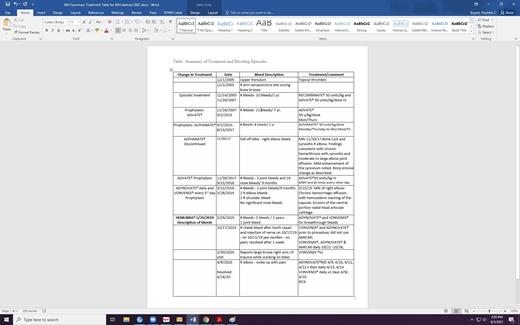Abstract
It is unusual to have both Type 2N VWD and severe hemophilia A. Type 2N (Normandy) von Willebrand Disease (VWD) is an uncommon recessive disorder resulting in a defect in the binding site of von Willebrand Factor (VWF) with factor VIII. Factor VIII plasma levels are low due to rapid clearance. Our patient has severe hemophilia A (factor VIII <1%; Inversion 22) with no history of inhibitors and is heterozygous for a known pathogenic mutation (c2560C>T; p. Arg854Trp) Type 2N "Normandy". He benefited from the use of HEMLIBRA® (Emicizumab-kxwh, Genentech) a humanized bispecific monoclonal antibody with a long half-life independent of VWF interaction.
The patient was diagnosed at 11 months old with excessive bleeding from his frenulum and began episodic standard factor VIII. He had 10 bleeds including knees, arms and hamstring before starting prophylaxis at 3 yrs. of age. On ADVATE 50 units/kg/dose twice a week he had nose bleeds, soft tissue bleeds, and joint bleeds. At 11 yrs. of age, the nose bleeds increased daily. VWD testing revealed VWF activity 25%, VWF Antigen 42%, Factor VIII <1% and Normal Multimers with Type 2 Normandy genotype. ALPHANATE® (Anti-hemophiliac factor/von Willebrand factor complex (human), Grifols) prophylaxis was started to address mucosal bleeding however the right elbow synovitis progressed to right elbow contracture and bone cyst on MRI. He returned briefly to ADVATE® 50 units/kg MWF to every other day prophylaxis with continued intermittent bleeding in right elbow joint. With the diagnosis of Type 2N, and the availability of VONVENDI ® (Recombinant von Willebrand factor, Takeda), he was placed on ADYNOVATE® (Antihemophilic Factor Recombinant PEGylated, Takeda) daily and VONVENDI® every 3rd day starting at 14 yrs. old. The combination of ADYNOVATE® every 12-24 hours with VONVENDI® daily to every other day improved his acute bleeding episodes including his nose bleeds (Half-life ADONYVATE®+VONVENDI® 9.25 hr. vs. Half-life ADVATE® 5.5 hr.). The patient continued to participate in high-risk activities such as playing on trampoline which contributed to his injuries but his family felt the treatment was better than previous therapies.
After considering the treatment burden of 2 types of factors more than 5 times a week and progression of synovitis in right elbow joint, the patient was started on HEMLIBRA® with weekly subcutaneous injections. Four weeks of loading dose (3 mg/kg/dose) was followed by once per week prophylaxis at standard dosing 1.5 mg/kg weekly. The first bleeding episode on HEMLIBRA® was reported after tooth restoration October 2019. After receiving both ADYNOVATE® and VONVENDI® pre-op, he developed swelling with suspected hematoma at the angle of his jaw about 4 days post-op treated successfully with ADYNOVATE® /VONVENDI®. In April 2020, he had right elbow pain stereotypic of a joint bleeding episode after yard work which was treated successfully with ADYNOVATE® /VONVENDI®. No report of severe nosebleeds.
To our knowledge this is the first example of successful use of HEMLIBRA® in a patient with Type 2N VWD and severe hemophilia A. It is unclear why the ALPHANATE® was not clinically effective however the combination of VONVENDI® and ADYNOVATE® provided improved hemostasis with frequent infusions and high cost before the start of HEMLIBRA®. HEMLIBRA once a week has significantly reduced the treatment burden and improved bleeding prevention. The genotype of this patient is unusual however this approach may be successful in other types of VWD that result in significant bleeding phenotype.
Bryant: Novo Nordisk: Consultancy, Honoraria; Bristol Myers Squib: Consultancy, Honoraria; Hema Biologics: Consultancy, Honoraria. Carr: Genentech: Speakers Bureau; Bayer: Speakers Bureau; Medexus: Speakers Bureau.


This feature is available to Subscribers Only
Sign In or Create an Account Close Modal